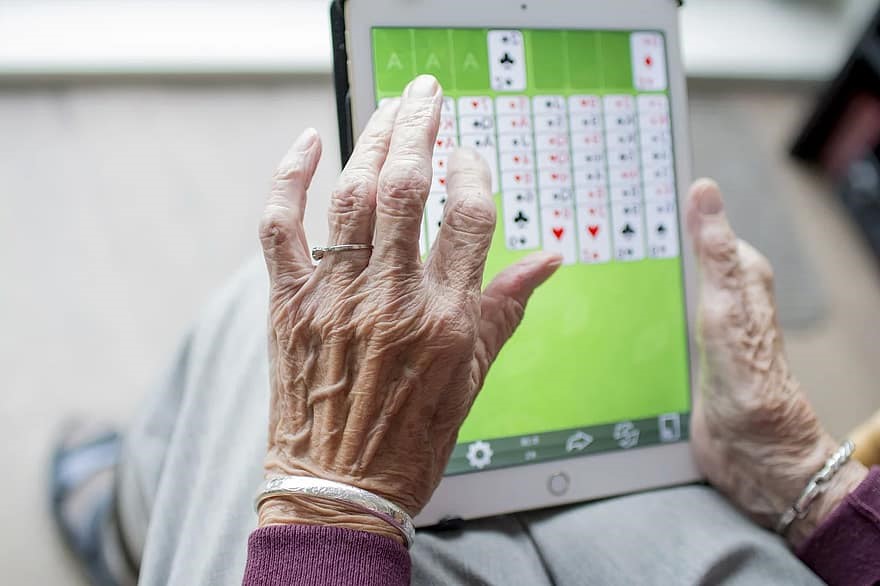When was the last time you did not use any technology for a whole day?
Technology is one of our ‘best friends’. As it becomes smaller, more automatic, and better adjusted to our needs, technology is helping us in more and more areas in life. We have our smartphones with us all the time. For the so-called ‘Millennial generation’, being surrounded by technological solutions is so obvious that it is challenging to remember life before we had access to these technological advances.
Younger generations do not remember life without modern technologies. Using the newest smartphones and laptops will be as obvious for them as riding a bike was for us Millennials.
During the COVID-19 pandemic with its self-isolation requirements, many of us experienced how important technology is to communicate with older adults, especially with people with dementia. This pandemic also amplified questions that many researchers and clinicians were already asking: Is current technology feasible for older adults and people living with dementia? Is technology accessible to use in residential care?

The benefits and challenges of technology for older adults and people with dementia
The majority of low-cost assistive technologies, such as reading glasses, pill organisers, are mostly feasible for older people and meet their needs. When we start thinking about digital technologies (like smartphones, laptops and built-in applications) – they are not always meeting older people needs and wishes.
There is an increasing need to implement digital technologies into the “aged care sector”. However, the needs of older people are different than those of other generations and the majority of technology producers and designers do not have older people or people with dementia in mind while they are creating new products. Often such technologies are not used as people with dementia and their carers need to see technology as beneficial and useful before adopting it in their lives.
Many older people can be disappointed after purchasing phones and other assistive technologies as they may not be able to operate them or fix apparent problems. The constant updates and software changes can be frustrating.
Although many older people can successfully use video-conferencing apps on iPad/Tablets, there is a group among them with more advanced cognitive decline and physical frailty who struggle using them. Communication technology like Skype and FaceTime is important, especially in the face of a global pandemic. During Covid-19, many of us were not able to stay in touch with our older relatives and friends because they could not use or did not have access to standard communication applications. These apps often require assistance from other people, creating a significant barrier for people living alone or even those in residential care.
One of the possible solutions could be the use of telepresence robots, such as Giraff. Family have control of virtually driving the robot, connecting the robot and setting the camera so that both the older person and their relatives and friends can see each other. This allows the older people with dementia to see their family, without having to learn new skills like using an iPad/tablet with additional apps. Additionally, telepresence robots, which are much bigger than tablets or smartphones, are less easily misplaced!

What do older adults really want from technology?
Older adults stress that they would like particular technologies being designed to blend with their surroundings, and do not suggest that they need more help. There is increasing interest in smart home solutions for older people and people with dementia, as smart home applications, such as the Amazon Alexa, are becoming more popular in society. These solutions could help older people become more accepting of technology as they can adjust certain functions to their individual needs. Future studies should also take privacy and security issues into account while creating and testing new digital technologies. These concerns have also been raised along with an unmet need for more friendly technical support.
This is why it is fundamental to include the perspectives of older people, those living with dementia and their carers in the development of technology. These groups know what type of technology they want to use. Technology for older people needs to be less complex and intrusive.
We need to make technology useful and easy to use for older adults. We must challenge the research and design community to get to “know the user”, and better understand the needs, preferences and abilities of older people. The Australian Aged Care Technology Collaborative aims to identify technological needs within the aged care sector, developing a better understanding of what older adults view as priorities and unmet needs in terms of technology. The results from our study will help to shape the direction for future technology studies. We will also develop an easily accessible website that will help people to find information of what choices are already available.
If you would like to contribute to the Australian Aged Care Technology Collaborative, you can participate in our online survey. Together, we can make a difference for older adults and people with dementia, by ensuring future technological developments reflect their needs and their abilities.

Dr Katarzyna Lion is a Research Fellow at Menzies Health Institute Queensland, Griffith University. She is a part of the Australian Aged Care Technology Collaborative lead by Prof Wendy Moyle. The project was funded by the Griffith University 2019 MHIQ Capacity Grant Scheme.
Twitter: @KatarzynaLion
Email: k.lion@griffith.edu.au




